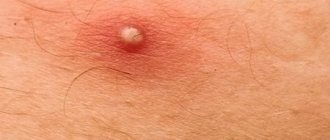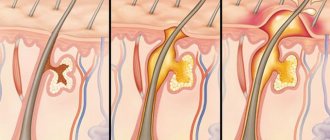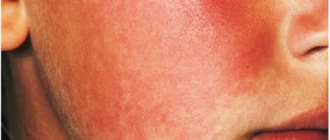A furuncle is a purulent inflammation of the hair follicle and adjacent tissues. The cause of nasal boils is staphylococcal and streptococcal infections. Several boils, merging, can form a carbuncle. The treatment regimen depends on the severity of the inflammatory process. In cases of suppuration, surgical opening of the boil is prescribed.
How does a nasal boil develop?
The initial acute stage of the disease is characterized by a feeling of discomfort in the vestibule area. Pain appears, which can be of varying intensity - from not too strong to unbearable. Often the pain intensifies at night. If the boil turns black in the middle, this indicates that the root of the boil has formed. Characteristic symptoms:
- hyperemia of the affected area;
- swelling;
- pain at the site of the lesion;
- pain when pressed;
- increased body temperature (systemic symptom).
A laboratory blood test may reveal toxemia. In the next stage (purulent boil), if measures were taken at the wrong time or the treatment was not adequate, the symptoms become more complicated. Diagnosed:
- thrombus formation in the area of the angular vein (outwardly resembles the appearance of a thickened cord);
- increase in general body temperature to significant values;
- swollen lymph nodes;
- swelling of the eyelids, hyperemia of the mucous membrane of the eye, difficulty moving the eyeballs, pain;
- blurred vision;
- bulging eye.
If you do not receive qualified help, swelling of the optic nerves may occur, which leads to complete or partial paralysis of the eye muscle.
Clinical picture
Within two days from the onset of the disease, compaction, hyperemia (increased blood supply to the tissue), and swelling in the area of the hair follicle appear. Pain also appears, which intensifies with chewing and facial muscle tension. There is a headache, fever, and general weakness. A peripheral blood test shows an increase in ESR (erythrocyte sedimentation rate). After 3 or 4 days, the head of the abscess appears, which has a yellowish-white color. In the following days (usually 2-4 days pass), the center of the infiltrate becomes soft and a small amount of pus is released. The necrotic (dead) shaft of the hair follicle is rejected, the cavity of the abscess is cleansed, which is filled with granulations (tissues that develop during the healing of the source of inflammation). Pain sensations decrease, temperature returns to normal, and general condition improves significantly.
Friends! Timely and correct treatment will ensure you a speedy recovery!
In some cases, abscess formation (limited accumulation of pus in the tissues) of the boil is observed.
Forms
The disease has two stages: in the first, the formation of an infiltrate (closed boil) occurs. In the second, pus appears, the pain intensifies and additional symptoms develop. Pus forms at the site of infiltration if you do not consult a doctor in time. In the first stage, the boil does not hurt much. The second stage is characterized by a deterioration in general condition and increased pain. Often in the second stage it is necessary to resort to surgical treatment of the boil. Complications after opening a boil usually develop if the opening was performed in violation of the rules of asepsis or by a non-specialist. The boil incision should not be wetted, as this promotes re-entry of infection and complicates the regeneration process. Is it possible to squeeze out a boil on your own? Attention! Under no circumstances should such attempts be made, as this can cause serious complications that threaten health and even life.
Causes and course of the disease
The cause of a carbuncle or boil of the nose is staphylococcus. Due to the prevalence of carriage, Streptococcus aureus plays a dominant role. The cause of a boil can also be streptococci (beta - hemolytic streptococcus of group A). Groups of streptococci such as viridans and non-hemolytic cause this disease much less frequently. The development of the disease is significantly influenced by a decrease in human immunity. This helps to increase the number of boil recurrences. The following diseases have an adverse effect on the course of the disease, increase the frequency of relapses and affect the prognosis:
- hypovitaminosis;
- diseases of the digestive system;
- diabetes.
The penetration of infection into the area of the external nose and the vestibule of the nasal cavity is facilitated by:
- violation of skin integrity due to microtraumas;
- skin pollution;
- the influence of such production factors as cement and coal dust, fuels and lubricants;
- overheating or hypothermia, which significantly reduce the anti-infective resistance of the skin.
Two or three boils may merge together to form a carbuncle. In this case, an increase in local inflammation is observed. The hair follicle is surrounded by an inflamed infiltrate (accumulation of fluid in the tissues of cellular elements mixed with lymph and blood). The process of thrombosis begins in small venous vessels. An increase in infiltrate can cause the spread of thrombosis into the vessels of the skull, which can lead to the development of severe intracranial complications or sepsis.
How does staphylococcus bacteria get into the nose and develop a boil?
A person can be a carrier of infections and not know it. Under suitable conditions (hypothermia, decreased general protective properties, exacerbation of any chronic pathology of the body, stress, increased physical activity, alcohol abuse), streptococci or staphylococci begin to manifest themselves. The formation of a boil is promoted by:
- failure to comply with personal hygiene rules;
- hazardous production;
- hypothermia or overheating of the body;
- diseases of the gastrointestinal tract;
- unbalanced diet with insufficient amounts of vitamins, minerals, microelements;
- endocrine diseases;
- reduced immunity.
Stages of development
The first stage in the development of the disease is a traumatic injury to the skin and nasal mucosa (such as an abrasion, scratch or cut), through which the infection penetrates deep into the tissue. The causative agent of the disease is usually pathogenic staphylococci and streptococci. The infectious agent then spreads along the hair root into the follicle. This process is accompanied by local inflammation and the formation of a painful infiltrate. This stage of the boil is called the infiltration stage. After this, necrosis develops and a necrotic core is formed. The surrounding tissues undergo melting and transform into purulent masses, after which they begin to accumulate under the layer of epidermis surrounding the mouth of the follicle, which is why a subcutaneous abscess develops. This stage of the boil is called the abscess stage.
Diagnostics
Diagnosis should only be carried out by a doctor in a clinical setting. The doctor conducts an external examination, collects anamnesis and prescribes the necessary laboratory and diagnostic measures. Laboratory tests include: a general blood test, determining the number of neutrophils and ESR, a urine and blood test for carbohydrate content to exclude diabetes mellitus. In some cases, the material is examined to determine the pathogen (smear culture and antibiotic sensitivity determination). If necessary, consultation with doctors of related specialties (gastroenterologist, endocrinologist, dermatologist) is carried out.
Treatment
Treatment of nasal boils is indicated in a hospital setting. Treatment is prescribed depending on the stage of development of the inflammatory process. In the infiltration stage, the inflammation site is carefully wiped with a solution of ethyl alcohol (70%) or two percent salicylic alcohol. 2% mupirocin and fusidic acid ointment is also used.
For systemic therapy, oxacillin and cephalexin are prescribed. Cefazolin, Augmentin, Panclave, and vancomycin are prescribed as alternative drugs.
UFO (ultraviolet irradiation) and UHF (ultra-high frequency) therapy in the centimeter range have a positive effect. In case of a protracted course of the disease, autohemotherapy (treatment with one’s own blood) is prescribed, as well as general restorative treatment: vitamins A and C, iron supplements, fish oil.
In case of abscess formation (limited accumulation of pus in tissues), surgical treatment is necessary, in which the abscess is opened and the pus is removed.
Description of the disease
Boils can occur in both young children and adolescents. Today they are the most common purulent skin lesion. Inflammation can affect any area where there are hair follicles. Most often, boils appear on the child’s head and neck, less often on the body (in the groin, on the back or stomach, under the armpit), on the legs and arms. The main feature of the course of this pathology in children is the high risk of inflammation spreading to neighboring tissues and structures, as well as its spread through the bloodstream, leading to the development of dangerous complications.
Causes
Other reasons may be: hypothermia, vitamin deficiency, diabetes, skin injuries. Often several ulcers are observed at once, which are concentrated not only in the nose area, but also in other parts of the face and body. This spread of infection indicates the development of furunculosis.
Particularly severe forms of the disease are accompanied by the formation of carbuncles, when two (or more) boils merge into one lesion.
If left untreated, there is a risk of thrombosis of small veins, which opens the way to the vessels of the skull, which creates the risk of intracranial complications. Sepsis may develop.
Prognosis and prevention
Single boils that occur without complications completely disappear within 2-3 weeks.
With relatively frequent relapses (exacerbations once a year or more often), the likelihood of complications is much higher. In this case, regular monitoring, immunostimulating procedures, and treatment of underlying diseases are required. Prevention of the development of boils in children includes careful skin care, regular hardening and strengthening of the immune system, timely treatment of acute and chronic diseases.
A boil is not just a pimple. An abscess can cause severe complications, including sepsis and meningitis, which is why any such formation on the body of a child or teenager requires careful monitoring. The specialists of the SM-Doctor clinic will select the optimal method of treating and preventing this problem.
Symptoms
Symptoms of a nasal boil include:
- mild itching and (or) feeling of a foreign body in the area of the vestibule of the nose,
- pain (pain can be moderate to severe), pain can occur when touching a sore spot, can be constant,
- swelling and redness of soft tissues in the nasal area of varying prevalence,
- temperature (up to 38 - 38.5 degrees C).
Do not try to treat a nasal boil yourself! Immediately consult a doctor who will decide on surgical or conservative treatment.
Pathogenesis and stages of development
During the development process, the boil goes through three successive stages:
- initial (infiltration): the inflammatory process begins at the mouth of the follicle and gradually spreads;
- necrotic (maturation): inflammation engulfs the entire cavity of the follicle, causing necrosis and purulent melting of tissue; the process lasts from several days to 2 weeks and ends with a rupture of the skin over the center of the boil;
- healing stage: after the pus has drained and the cavity of the lesion has been cleaned, it gradually scars with the formation of a scar.
Causes of boils in children
Most often, inflammation develops due to tissue damage by Staphylococcus aureus, less often the causative agent is other groups of staphylococci or streptococci. All of them are on the skin almost constantly, but in a normal state of immunity they cannot cause disease. The pathological process starts when exposed to certain unfavorable factors:
- wounds, scratches on the skin;
- skin diseases (eczema, atopic dermatitis);
- decreased immunity due to acute respiratory viral infections, operations, injuries, exacerbation of chronic diseases);
- congenital immunodeficiency conditions;
- diabetes mellitus and metabolic disorders (often cause the constant appearance of boils in a child);
- chronic infections: tuberculosis, pyelonephritis, sinusitis, etc.










